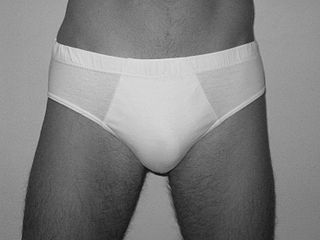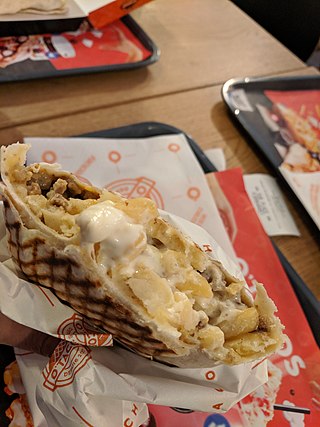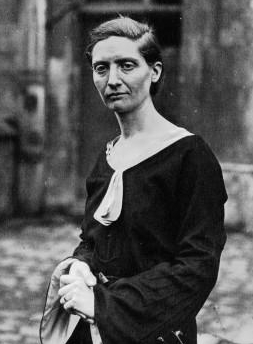Related Research Articles

Panties are women's form-fitting underpants. Typical components include an elastic waistband, a crotch panel to cover the genitalia, and a pair of leg openings that, like the waistband, are often made of elastomer. Various materials are used, but are usually chosen to be breathable.

Nightwear – also called sleepwear, or nightclothes – is clothing designed to be worn while sleeping. The style of nightwear worn may vary with the seasons, with warmer styles being worn in colder conditions and vice versa. Some styles or materials are selected to be visually appealing or erotic in addition to their functional purposes.

Fundoshi (ふんどし/褌) is a traditional Japanese undergarment for males and females, made from a length of cotton.

Lille Olympique Sporting Club, commonly referred to as LOSC, LOSC Lille or simply Lille, is a French professional football club based in Lille, Northern France competing in Ligue 1, the top division of French football. Lille have played their home matches since 2012 at the Stade Pierre-Mauroy. The 50,186-capacity retractable roof venue is the fourth-largest stadium in France.
France 4 is a French free-to-air television channel owned by France Télévisions, focused on children's programming. The colour of France 4 is purple.

Givenchy is a French luxury fashion and perfume house. It hosts the brand of haute couture and ready-to-wear clothing, accessories, perfumes and cosmetics of Parfums Givenchy. The house of Givenchy was founded in 1952 by designer Hubert de Givenchy and is a member of Chambre Syndicale de la Haute Couture et du Prêt-à-Porter. It is currently owned by luxury conglomerate LVMH.
The Izod Corporation is an American midrange clothing company that produces dressy-casual clothing, sportswear for men, and footwear and accessories. It is a division of Authentic Brands Group, and is currently marketed and manufactured by Centric Brands under a long-term licensing agreement for most products. Other Izod classics include the Harrington jacket G-9 model and V-neck and cardigan sweaters. Today, the closest competitor of the Izod brand is the Chaps brand owned by Ralph Lauren Corporation, while the U.S. Polo Assn. brand is also an indirect competitor.
Jean Cacharel SA is a French company of ready-to-wear clothing, perfume and accessories, founded in 1958 by Jean Bousquet. Cacharel designs are characterized by their youthful style, femininity, lightness, refinement, and use of bright colours. Cacharel is named after the local name of the garganey in the Camargue.

Briefs are a type of short, form-fitting underwear and swimwear, as opposed to styles where material extends down the thighs. Briefs have various different styles, usually with a waistband attached to fabric that runs along the pelvis to the crotch and buttocks, and are worn by both men and women. Swim briefs are a variation used as swimwear.

Funpals is a children's underwear name brand that was established in 1985 in order to compete with Underoos. Its trademark was renewed on March 17, 2005, by William R. Hansen, trademark correspondent.

Underwear, underclothing, or undergarments are items of clothing worn beneath outer clothes, usually in direct contact with the skin, although they may comprise more than a single layer. They serve to keep outer clothing from being soiled or damaged by bodily excretions, to lessen the friction of outerwear against the skin, to shape the body, and to provide concealment or support for parts of it. In cold weather, long underwear is sometimes worn to provide additional warmth. Special types of undergarments have religious significance. Some items of clothing are designed as undergarments, while others, such as T-shirts and certain types of shorts, are appropriate both as underwear and outerwear. If made of suitable material or textile, some underwear can serve as nightwear or swimwear, and some undergarments are intended for sexual attraction or visual appeal.
BETC is a French advertising agency founded in Paris in 1995. The name of the company stands for Babinet, Erra and Tong Cuong, the founding members.

A marinière, or tricot rayé, is a cotton long-sleeved shirt with horizontal blue and white stripes. Characteristically worn by quartermasters and seamen in the French Navy, it has become a staple in civilian French fashion and, especially outside France, this kind of striped garment is often part of the stereotypical image of a French person. It is also known as a Breton shirt, as many sailors in the French Navy were from Brittany.

Claude Ponticelli, known as Claude Ponti, was born on November 22, 1948, in Lunéville. He is a children's author and illustrator. His books are known for lush visual design and illustrations, alongside imaginative and poetic stories, showcasing Claude Ponti's skills as an iconic and complete artist, with a unique and distinctive universe.
Sunspel is an English luxury clothing brand, founded in England in 1860. The brand is best known for boxer shorts, T-shirts and polo shirts. It is based in Long Eaton, near Nottingham, where it has its own factory.

A French tacos, Lyonese tacos or matelas, is a fast food dish which usually consists of a flour tortilla grilled and folded around a filling of French fries, cheese, and meat, among other deli ingredients.

Mathilde Gerner, better known by her stage mononym Hoshi, is a French singer-songwriter.

Bouchara is a French brand of household linen, furnishing fabric and decoration, founded in Marseille in 1899 by Jacques Bouchara. Bouchara sells decorative items, household linens, tableware, fabrics and interior clothing.

Rose Angéline Alexandrine Celli was a French novelist, playwright, translator and poet. She wrote children's books, poetry and novels for adults, and is best known for her children's books published as part of the Père Castor series.

Ron Dorff is a French-Swedish sportswear brand for men founded in 2012 by Claus Lindorff.
References
- ↑ http://www.tendances-de-mode.com/2010/05/19/1756-petit-bateau « Petit Bateau », by Lise Huret on tendances-de-mode.com, May 19, 2010 (consulted October 27, 2014).
- ↑ EOLAS. "La bonneterie : l'Aube, capitale de la maille - Département de l'Aube". www.aube.fr (in French). Retrieved 2018-02-22.
- 1 2 3 "Petit Bateau: the boat that rocked - Telegraph". fashion.telegraph.co.uk. Retrieved 2018-02-22.
- ↑ Fauconnier, Virginie (15 February 2013). "Petit Bateau rhabille les 18-108 ans". Le Parisien (21286): 80–81. Archived from the original on 2019-03-13.
- 1 2 3 "Elle porte la culotte". Libération.fr (in French). Retrieved 2018-02-22.
- ↑ "Petit Bateau (Marque de mode) - Tendances de Mode". www.tendances-de-mode.com. Retrieved 2017-12-21.
- ↑ "Comment Petit Bateau s'est inspiré des G.I.'s américains". RTL Radio, Émission "Il était une marque". 14 August 2015. Retrieved 2017-12-21.
- ↑ "Télématin". www.france2.fr. 14 February 2017.
- 1 2 3 Conso, L. S. A. (5 April 2012). "Petit Bateau vogue sur les codes de l'enfance". lsa-conso.fr. Retrieved 2017-12-21.
- ↑ Sandie Meusnier (11 May 2007). "Et vogue le Petit Bateau !". Madame Figaro. Retrieved 2017-12-21.
- ↑ "Petit Bateau : 91 ans au service des petits comme des grands". Glamour Paris. 15 August 2011. Retrieved 2017-12-21.
- 1 2 "Petit Bateau a des jambes et marche bien". Ouest-France.fr. 27 December 2012. Retrieved 2017-12-21.
- ↑ "Visite privée dans les coulisses de la collection été de Petit Bateau". leparisien.fr. 5 May 2017. Retrieved 2017-12-21.
- 1 2 "Petit Bateau : et vogue la légende…". Madame Figaro. 14 July 2011. Retrieved 2017-12-21.
- ↑ "Success story : la culotte Petit Bateau". Marie Claire (in French). Retrieved 2018-02-22.
- ↑ "Petit Bateau réinvente la marinière". Femme Actuelle. Retrieved 2018-02-22.
- ↑ "Mode. Quand le pêcheur breton envahit les dressings". jactiv.ouest-france.fr (in French). Retrieved 2018-02-22.
- ↑ Catherine., Ormen-Corpet (2000). Modes XIXe-XXe siècles. Paris: Hazan. ISBN 2850257303. OCLC 412433026.
- 1 2 "Petit Bateau mène sa marque". LExpress.fr. 13 June 2002. Retrieved 2017-12-21.
- 1 2 3 4 "Petit Bateau : 1 440 mois et vogue le succès - Stratégies". Stratégies (in French). 2013-09-05. Retrieved 2018-02-22.
- ↑ Ruaud, Sabine; Boulocher, Véronique (2017-02-26). Analyse de marché: De la définition au diagnostic (in French). Vuibert. ISBN 9782311403466.
- ↑ "Petit Bateau: For Serious Kids by BETC Paris". The Drum. March 2016. Retrieved 2017-12-21.
- ↑ "Le tourbillon Petit Bateau". CB News. 5 November 2015. Retrieved 2017-12-21.
- ↑ Mélanie Roosen (28 August 2017). "Petit Bateau revient en mode crash test". ladn.eu.
- ↑ "Petit Bateau se met à la musique avec Spotify". Madame Figaro (in French). Retrieved 2018-02-22.
- ↑ Média, Prisma. "Carven en eaux chics avec Petit Bateau - Gala". Gala.fr (in French). Retrieved 2018-02-22.
- ↑ Trochu, Eugénie. "Tsumori Chisato et Petit Bateau, saison 2". Vogue (in French). Retrieved 2018-02-22.
- ↑ "Mode". Cosmopolitan.fr (in French). Retrieved 2018-02-22.
- ↑ "Cédric Charlier revisite la marinière Petit Bateau - Elle" (in French). 2014-09-04. Retrieved 2018-02-22.
- ↑ Grazia.fr (2013-09-19). "Christian Lacroix emmène Petit Bateau à l'Opéra Garnier". Grazia.fr (in French). Retrieved 2018-02-22.
- ↑ "Collaboration : quand Petit Bateau accueille à son bord la maison Kitsuné". O (in French). Retrieved 2018-02-22.
- ↑ "Jean-Charles de Castelbajac embarque pour Petit Bateau". Madame Figaro (in French). Retrieved 2018-02-22.
- ↑ Assor, Constance (2016-08-29). "Petit Bateau donne carte blanche à Inès de la Fressange". Le Point (in French). Retrieved 2018-02-22.
- ↑ Grazia.fr (2015-07-24). "K-Way x Petit Bateau : quand l'imper fusionne avec la marinière". Grazia.fr (in French). Retrieved 2018-02-22.
- ↑ "Petit Bateau la joue naturaliste avec Deyrolle". FashionNetwork.com. 24 February 2017. Retrieved 2017-12-21.
- ↑ Périer, Marie. "Petit Bateau x Keith Haring, la collection pop pour petits et grands". Vogue (in French). Retrieved 2018-02-22.
- ↑ "Les gribouillis de Petit Bateau et Hervé Tullet". www.dailyelle.fr. 16 April 2013. Retrieved 2017-12-21.
- ↑ "Collection capsule : Petit Bateau + L'école des loisirs". MilK (in French). Retrieved 2018-02-22.
- ↑ "Les tutos vidéos des ateliers Tok-Tok avec Petit Bateau". L’ADN. 10 April 2017. Retrieved 21 December 2017.
- ↑ "Made in France – Une marque nous mène en bateau" (in French). Retrieved 2018-02-22.
- ↑ "Pour ses 120 ans, Petit Bateau rend hommage à ses ouvriers". Le Monde.fr (in French). 15 May 2013. Retrieved 2018-02-22.
- 1 2 "Petit Bateau cherche à multiplier les partenariats à l'international". Le Monde.fr (in French). 4 October 2012. Retrieved 2018-02-22.
- ↑ "Soldes : que cache l'étiquette de votre tee-shirt ?". Franceinfo (in French). 2014-01-08. Retrieved 2018-02-22.
- ↑ "Vidéo - François Hollande visite l'usine de Petit Bateau ce jeudi matin". lest-eclair.fr (in French). Retrieved 2018-02-22.
- ↑ "Petit Bateau lance son appli de recyclage". MilK (in French). Retrieved 2018-02-22.